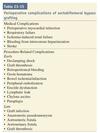Arterial Disease Flashcards
An ankle brachial index that suggests increased risk of myocardial infarction
<0.9
Abdominal aortic aneurysm
- 10TH LEADING CAUSE OF DEATH FOR MEN
- Risk of rupture is low when below 5.5 cm
- Overall moratlity rate of AAA rupture is 71 to 77%
- Women appear to be at thigher risk of ruptures
- 4.5 cm to 5 cm
The compartment most commonly affected in a lower leg compartment syndrome
Anterior
- Numbness in the web space between the forst and second toes is diagnostic
- compression of the deep peroneal nerve
- Pressures greater than 20 mmHg are an indication for fasciotomy
Contraindications of MRA
- Pacemakres
- defibrillators
- spinal cord stimulators
- intracerebral shunts
- cochlear implants
- cranial clips
MRA has the advantage of not requiring iodinated contrast. Gadolinium is not nephroptoxic
Nitimol stents produce minimal artifacts
Metallic stents causes artifacts and signal drop out, howeverm these can be dealth with using alternations in image acquisition and processing
The preferred procedure for treatment of typical occlusive disease of the aorta and both ilicac arteries
Aortobifemoral bypass
- performed becasue patients usually have disease in both iliac systmes
- long term patency (70-80% at 10 years)
The most common cause of ischemic stroke is
Cardiogenic emboli
- Cardiogenic emboli (35%)
- Carotid artery disease (30%)
- lacunar (10%)
- Misc (10%)
- idiopathic (15%)
The treatment of acute embolic mesenteric ischemia
Operative embolectomy
The correct classification for the degree of stenosis in the internal carotid artery of a patient with a luminal diameter of 69%
Moderate
Mild (<50%) Moderate (50-69%) severe (70-99%)
The treatment of nonocclusive mesenteric ischemia is
Catheter infusion of papaverine
- intraarterial papaverine is given at adose of 30 to 60 mg/h this must ne coupled woth the cessayion of other vasoconstricting agents
Hollenhorst plawur is founf within the
Retinal vessels
- cholesterol embolization from the carotid bifurcation
- Amaurosis fugax
- transient monocular blindness,
- lasts for a few minutes and then resolves
- due to embolic occlusion of the maina rtery or the upper or lower divisions
The msot accurate diagnostic test with the lower motor morbidity in the diagnosis of renal artery stenosis is
MRA
The risk of a recurrent ipsilateral steoke in patients with severe carotid stenosis
40%
Carotid body tumors
- Usually benign
- Carotid body originates from the third branchial arch and from neuroectodermal derived neural crest lineage.
- The normal carotid body is located in the adventitia or periadventitial tissue at the bifurcation of the common carotid artery
Major risk factors associated with carotid stenosis disease progression
- cigarette smoking
- Diabetes melliutus
- age
Rest pain seen with occlusive peripheral vascular disease in the lower lextremity most commonly occurs in
The metatarsophalangeal joint
- requires placing the foot in a dependent position to improve symproms






